

D.campusfrance.org/fria/edsearch/index.html?siteroot= Présentation. Le Suivi de populations de plantes. 4.1 Suivi scientifique : introduction et généralités. Prairies AOP - [ACCUEIL] Arc Jurassien: Interreg. Corine Land Cover. Action 1: Herbe. Prairies fleuries, biodiversité préservée - Europe en Rhone-Alpes. Quoi de plus beau et de plus utile qu’une flore diversifiée dans les montagnes du Parc Naturel Régional des Bauges (73 et 74).
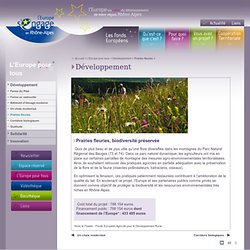
Dans ce parc naturel dynamique, les agriculteurs ont mis en place sur certaines parcelles de montagne des mesures agro-environnementales territorialisées. Ainsi, ils souhaitent retrouver des pratiques agricoles en parfaite adéquation avec la préservation de la flore et de la faune (insectes pollinisateurs, batraciens, oiseaux). En optimisant la fenaison, ces pratiques patiemment restaurées contribuent à l’amélioration de la qualité du lait. En soutenant ce projet, l’Europe et ses partenaires publics comme privés se donnent comme objectif de protéger la biodiversité et les ressources environnementales très riches en Rhône-Alpes.
Urep SOERE. Les étapes du diagnostic d'une prairie.
The Long Term Ecological Research Network. Grassland stream research: Konza Prairie LTER research includes numerous studies on the ecology of grassland streams.
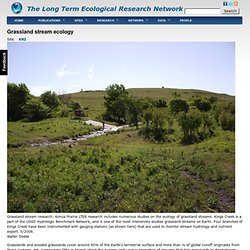
Kings Creek is a part of the USGS Hydrologic Benchmark Network, and is one of the most intensively studies grassland streams on Earth. Four branches of Kings Creek have been instrumented with gauging stations (as shown here) that are used to monitor stream hydrology and nutrient export. 5/2006. For further reading: Dodds WK, Gido K, Whiles MR, Fritz KM, Matthews WJ. 2004. The Long Term Ecological Research Network. Restoration ecology seeks to repair the diversity and dynamics of ecosystems degraded by human activities.
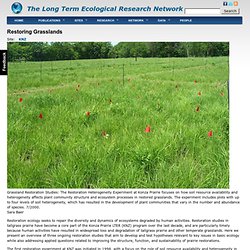
Restoration studies in tallgrass prairie have become a core part of the Konza Prairie LTER (KNZ) program over the last decade, and are particularly timely because human activities have resulted in widespread loss and degradation of tallgrass prairie and other temperate grasslands. Here we present an overview of three ongoing restoration studies that aim to develop and test hypotheses relevant to key issues in basic ecology while also addressing applied questions related to improving the structure, function, and sustainability of prairie restorations.
The first restoration experiment at KNZ was initiated in 1998, with a focus on the role of soil resource availability and heterogeneity in the restoration of plant community structure and ecosystem processes. The Long Term Ecological Research Network. Understanding the ecological effects of fire and grazing in grasslands is an important aspect of research at the Konza Prairie (KNZ) LTER site.

The tallgrass prairies of North America were shaped by natural disturbances that included periodic fires and the activities of ungulate grazers, and these remain important processes in tallgrass prairie and other grasslands around the world. In order to study the ecological role of fire and grazing, KNZ scientists pioneered the use of long-term, large-scale fire and grazing experiments.
The KNZ LTER program features a unique site-based experiment, established in 1977, that includes replicate watersheds subject to different fire and grazing treatments (Fig. 1), which has led to numerous important discoveries about how fire and grazing interact to affect the ecological dynamics of grassland communities at scales ranging from patches to landscapes, with relevance to grasslands globally.
The Long Term Ecological Research Network. Photograph of an experimental watershed on Konza Prairie that has been burned every four years in spring since 1971.

Note the high abundance and cover of several woody shrub species. Low and Intermediate fire frequencies allow for rapid increases in woody plant cover in these grasslands, with significant impacts on biodiversity, grassland consumers, and ecosystem processes. 6/2004 For further reading: Briggs, J.M., A.K. Knapp, J.M. Knapp, A.K., J.M. The Long Term Ecological Research Network. Adler, P.
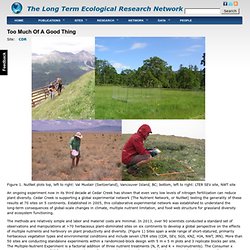
B., E. W. Seabloom, E. The Long Term Ecological Research Network. Rainfall Manipulation Plots (RaMPs) experiment: Konza Prairie LTER scientists are addressing the consequences of climate change using a unique experimental facility (the Rainfall Manipulation Plots, RaMPs) that allows them altered rainfall patterns and increase temperatures over replicated plots of native tallgrass prairie.
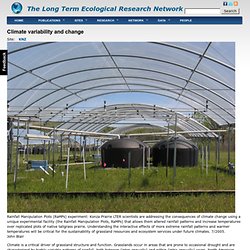
Understanding the interactive effects of more extreme rainfall patterns and warmer temperatures will be critical for the sustainability of grassland resources and ecosystem services under future climates. 7/2005. For further reading: Harper, C.W., J.M. Blair, P.A. CEFE. Research units > Biodiversity and Conservation > Projects > Biodiversity and livelihood in land-use gradients in Nepal. In this Nepal – Swiss research cooperation we study how different levels of land-use intensity (from primeval forests to arable fields) and climate do affect biodiversity on the southern slope of the Nepalese Himalayas.
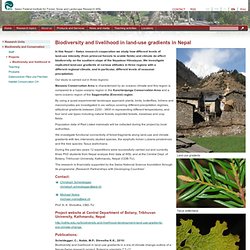
We investigate replicated land-use gradients at various altitudes in three regions with a different regional climate, and in particular, different levels of seasonal precipitation. Our study is carried out in three regions: Manaslu Conservation Area is characterized by an oceanic climate and this region is compared to a hyper-oceanic region in the Kanchenjunga Conservation Area and a semi-oceanic region of the Sagarmatha (Everest) region.
Population data of Red Listed mammals will be collected during the project by local authorities. We investigate functional connectivity of forest fragments along land-use and climate gradients with two intensively studied species, the epiphytic lichen Lobaria pindarensis and the tree species Taxus wallichiana. Forschungseinheiten > Biodiversität > projects > La diversité génétique au sein des espèces: un critère important pour comprendre la biodiversité de la florealpine. Forschungseinheiten > Waldressourcen > Projekte > Projet: Centre de données Nature et Paysage (DNL) Forschungseinheiten > Ökologie der Lebensgemeinschaften > Pâturages boisés et zones humides > Thèmes de recherche > Impact du réchauffement climatique sur les écosystèmes montagnards.
Le réchauffement climatique pourrait mettre en péril la végétation et les sols des pâturages boisés du Jura, et en conséquence aussi leur exploitation traditionnelle en estivage.

Ce paysage typique des sommets jurassiens est-il menacé? Le mode d’exploitation traditionnel des pâturages boisés jurassiens crée un paysage très diversifié, qui voit se côtoyer arbres isolés et herbages grâce à un acteur déterminant, le bétail. Par ses activités, le bétail façonne un milieu fait de transitions entre forêt et milieu ouvert. La biodiversité végétale y est ainsi très élevée: on a recensé jusqu’à 550 plantes vasculaires pour 70 km2 dans le Parc Jurassien vaudois, et il n’est pas rare d’en voir une quarantaine par m2.
Forschungseinheiten > Biodiversität > projects > Suivi des effets de la protectiondes biotopes en Suisse. Le projet "Suivi des effets de la protection des biotopes en Suisse », lancé en 2011 et mené conjointement par l’OFEV et le WSL, vise à montrer si les biotopes d’importance nationale (prairies et pâturages secs, zones alluviales, marais et sites de reproduction de batraciens) évoluent conformément aux objectifs de protection, c’est-à-dire si leur surface et leur qualité se maintiennent.
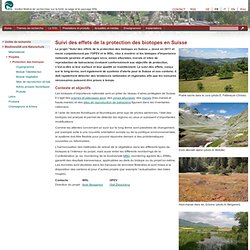
Le suivi des effets, conçu sur le long terme, sert également de système d’alerte pour la Suisse et ses cantons; il doit rapidement détecter des tendances nationales et régionales afin que les mesures nécessaires puissent être prises à temps. Projet de recherche. Projet de recherche SD/BD/05A (Action de recherche SD) Personnes : Prof. dr.